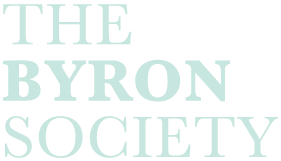By Roy Winnick
Few poets in the pantheon of British literature are as un-Byronic as the dour, proper, sometimes oppressively high-minded laureate Alfred Lord Tennyson. So among the many (I hope pleasant) surprises in my new Tennyson study, Tennyson’s Poems: New Textual Parallels, from Open Book Publishers, are the thirty-plus instances in which phrases of as few as two or three and as many as several words in Byron poems turn up verbatim or very nearly so in poems of Tennyson.
Childe Harold’s Pilgrimage leads the way with ten such echoes in Tennyson’s poems, the first in his first published poem, one of the last in In Memoriam. Don Juan follows, with four. Others, with one or two each, include (in alphabetical order—I’m looking at the index) A Sketch from Private Life; A Very Mournful Ballad on the Siege and Conquest of Alhama; Darkness; Heaven and Earth: A Mystery; Lara, A Tale; Lines inscribed upon a Cup formed from a Skull; Mazeppa; Sardanapalus, A Tragedy; and on through the alphabet.
Tennyson didn’t take kindly to any questioning of his originality. He called one scholar who presumed to do so (John Churton Collins) ‘a Louse on the Locks of Literature’ (or maybe—accounts vary—it was just ‘a jackass’).
[ezcol_1third] [/ezcol_1third][ezcol_2third_end]But the echoes of prior works—conscious or not, deliberate or not, meant to be noticed or not, meaningful or not—resonate throughout the Tennyson canon. And not just echoes of Byron. Pride of place goes to the King James Bible, with nearly seventy newly identified textual parallels. Other canonical authors with an abundance of such parallels include (again, alphabetically) Coleridge, Cowper, Dryden, Keats, Milton, Pope, Shakespeare, Shelley, and Wordsworth. Perhaps the biggest surprise textual-parallel-wise is Felicia Hemans, with just over forty newly discovered echoes of her works in those of Tennyson.[/ezcol_2third_end]
[/ezcol_1third][ezcol_2third_end]But the echoes of prior works—conscious or not, deliberate or not, meant to be noticed or not, meaningful or not—resonate throughout the Tennyson canon. And not just echoes of Byron. Pride of place goes to the King James Bible, with nearly seventy newly identified textual parallels. Other canonical authors with an abundance of such parallels include (again, alphabetically) Coleridge, Cowper, Dryden, Keats, Milton, Pope, Shakespeare, Shelley, and Wordsworth. Perhaps the biggest surprise textual-parallel-wise is Felicia Hemans, with just over forty newly discovered echoes of her works in those of Tennyson.[/ezcol_2third_end]
Was Tennyson, then, a serial plagiarist? While some may conclude so based on the abundance of textual parallels found in his work—a thousand-plus previously identified by Christopher Ricks and other scholars, a thousand-plus more in my study—I would not agree.
Rather, as I say in the preface of my study, I find in Tennyson an imagination of enormous range and power that regarded everything he had ever read, as well as the world around him, the people he knew, the people he loved (or didn’t), and his own personal and emotional experience, as the raw material of his art.
In mining that material as he did over seven decades, he created some of the most memorable and original poems ever written in the English language.
Dr Roy Winnick is an independent scholar with a particular interest in textual parallels. In addition to his most recent book, Tennyson’s Poems: New Textual Parallels, he has also published books on Frost (biography) and MacLeish (letters) and articles on Chaucer, Sidney, Shakespeare, Melville, Clough, Hardy, and Larkin. If you would like to read his Tennyson Study, it is available to read online or download for free from www.openbookpublishers.com/product/944.

